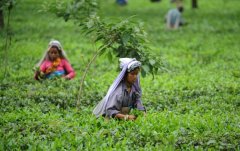What are the main processes of making tea from tea? Process flow chart of tea-making method
Our common teas are white tea, green tea, black tea and oolong tea. The process of making tea is roughly the same.
1) Chuan Qing: the first step in the production of tea is to use the newly grown buds or noodle leaves on the tea tree as raw materials.

(2) Sunlight withering: the green tea leaves are placed outdoors, so that part of the moisture naturally disappears from the sun, the leaf luster disappears into wavy undulation, and the hands feel soft, which is called "solar withering".

(3) Indoor withering: the withered tea green is put indoors to rest and stir each other, so that the leaf edge cells are damaged to facilitate fermentation and remove the bitter and smelly green taste of tea, which is called "indoor withering".

(4) fermentation: after the indoor withering is completed, let the tea green sit for several hours, contact with the air to play a role of slow oxidation, called "fermentation".

(5) killing green: when the tea green is fermented to the desired degree, put into the "green killing machine" to stop the tea green fermentation with high temperature, which is called "killing green". There are two ways to kill the green: fried green and steamed green. Green tea is directly withered (without wilting and fermentation). And black tea allows the green tea to continue to ferment (without killing the green).

(6) knead and twist: finish the killing, put it in the "kneading machine" and break the tea cells. It is gentle to pack and grow tea. Frozen top, high mountain tea and Tieguanyin are medium-soft and heavy-soft (cloth soft).

(7) drying: put the rolled tea green into the "dryer" to remove moisture for "drying". Dried unfinished tea, called "Mao tea" or "rough tea", can be sold to tea merchants at this time.

(8) roasting: after buying back "Mao tea", tea merchants still have to go through "roasting" treatment to bake the tea into light or ripe fragrance, but unfermented tea (such as green tea) does not need to be "roasted".

(9) finished product: finally, after the stem is pulled, the branch is inspected, and the tea is made, it can be packed and sold. After the tea is made, you can still smoke the flowers and put them on the ground. Wait.

Important Notice :
前街咖啡 FrontStreet Coffee has moved to new addredd:
FrontStreet Coffee Address: 315,Donghua East Road,GuangZhou
Tel:020 38364473
- Prev

The difference between the flavor and taste characteristics of hand-brewed coffee and cup-brewed coffee. How can coffee taste good?
How would you describe it when making coffee? Do you want to make coffee or make coffee? Or make coffee, make coffee? Obviously, the history of brewing coffee is the longest, and now, brewing coffee and brewing coffee is the mainstream. What is the difference between flushing and soaking? When we talk about brewing coffee, there are actually two ways of extraction. Brewing mostly refers to extracted coffee in the form of hand brewing.
- Next

What are the flavor characteristics of Darjeeling, Assam, Qimen and Ceylon black tea?
Darjeeling, Assam, Qimen and Ceylon many people taste black tea in coffee shops, teahouses and restaurants, even if they can understand the names of black tea listed on the menu, but they know nothing about its taste, aroma and even its compatibility with food. Not only that, the waiter will then ask, "would you like milk or lemon?" "generally speaking, people who know nothing about black tea
Related
- Beginners will see the "Coffee pull flower" guide!
- What is the difference between ice blog purified milk and ordinary milk coffee?
- Why is the Philippines the largest producer of crops in Liberia?
- For coffee extraction, should the fine powder be retained?
- How does extracted espresso fill pressed powder? How much strength does it take to press the powder?
- How to make jasmine cold extract coffee? Is the jasmine + latte good?
- Will this little toy really make the coffee taste better? How does Lily Drip affect coffee extraction?
- Will the action of slapping the filter cup also affect coffee extraction?
- What's the difference between powder-to-water ratio and powder-to-liquid ratio?
- What is the Ethiopian local species? What does it have to do with Heirloom native species?

